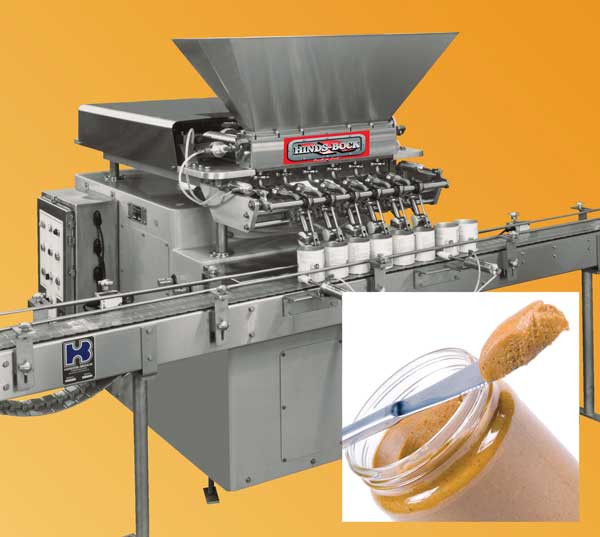How Nut and Seed Butters Are Processed
PROCESSING
This month’s food processing column follows the theme “How Is It Processed?” It will explore how nut and seed butters are processed. In recent years a variety of new nut and seed butters have entered the marketplace. Their predecessor, peanut butter, as well as these new products and the processes used to produce them, will be reviewed in the column.
 History, Market and Nutrition
History, Market and Nutrition
Peanut butter is considered the original nut butter. It can be traced back to the ancient Incas and Aztecs, who ground roasted peanuts into a paste. The discovery of modern peanut butter and peanut butter processing can be credited to three individuals. In 1884 Marcellus Gilmore Edson of Canada patented peanut paste produced by milling roasted peanuts between two heated surfaces. In 1895 Dr. John Harvey Kellogg patented a process for creating peanut butter from raw peanuts and marketed it as a nutritious protein substitute for people who had difficulty chewing solid food. And in 1903, another physician, Dr. Ambrose Straub of Missouri patented the first peanut butter manufacturing machine.
Peanut butter paved the way for other nut butters, including almond, cashew, walnut, and macadamia nut butters. Seed butters from sunflower, sesame, pumpkin, hemp, and other seeds are also popular. Sunflower seed butter (SunButter) is a very popular alternative to nut butters that was developed and commercialized in 2002 through a partnership between the U.S. Dept. of Agriculture’s Agricultural Research Service and SunButter LLC, Fargo, N.D.
In 2014 the overall nut and seed butter market was estimated to be $3.9 billion, according to Mintel. This market is expected to grow to $6.5 billion by 2018. Overall sales of peanut butter amounted to $1.9 billion in 2015. The average American consumes 4 pounds of peanut butter a year, according to 2015 USDA and census data. Peanut butter had a 45% share of nut butter launches, and almond butter had a 26% share in 2015, according to an article in The Wall Street Journal.
According to The Nutrition Source published by the Harvard T.H. Chan School of Public Health, “People who regularly eat nuts are less likely to have heart attacks or die from heart disease than those who rarely eat them.” High-quality nut and seed butters that do not contain added sweeteners or preservatives have nutrient profiles similar to the nuts and seeds from which they are made and as such are considered healthy foods. These butters are a good source of protein and fiber, as well as vitamins and minerals. Two tablespoons contain an average of 190 calories and 17 g of mostly heart-healthy unsaturated fat. A large percentage of consumers (46%) prefer butters with health claims associated with them over traditional varieties and are interested in products that do not contain preservatives or additives. Food regulations require that any product labeled as nut butter contain at least 90% nuts. Peanut butter must contain at least 90% peanuts and cannot contain artificial sweeteners, colors, or preservatives. Natural peanut butters cannot contain stabilizers, but may contain sweeteners and salt.
Peanut Butter Processing
Because peanut butter is the most commonly processed nut or seed butter, the process for peanut butter will be described in detail in this section. Processing of other types of nut and seed butters largely mirrors the peanut butter process.
• Planting, Harvesting, and Shelling. There are three main peanut varieties grown in the United States: Virginia, Spanish, and Runner. Runner peanuts are the most widely consumed, have high yields, and are the perfect size and uniformity for producing peanut butter. Peanuts are typically planted after the last frost in the spring when soil temperatures begin to warm up. After 120–160 days, the peanut plants are harvested in September and October. A digger-shaker uproots the plants, and the peanuts are mechanically harvested. The shells and foreign materials are then removed from the peanuts using screens, blowers, magnets, and destoners. Next the peanuts are graded for size, color, and other defects and packed into 2,000-pound bags for shipment to peanut butter processors.
• Roasting. The first step in the processing of peanut and other nut and seed butters is roasting. Dry roasting is done by either batch or continuous method. In the batch method peanuts are roasted at about 425°C in lots using revolving ovens. The preferred continuous method roasts shelled peanuts on belts at hot air temperatures between 160°C and 210°C for 20–40 min to enhance their flavor and color. This step also improves the safety of the butter. The nuts are normally vibrated or shaken as they are conveyed through the roaster to insure uniform heating. A photometer is frequently used to determine the completion of cooking.
• Cooling. Next the peanuts are cooled quickly to stop cooking and produce a uniform product. The hot peanuts pass from the roaster directly into a perforated metal cylinder (blower-cooler vat) or a stainless steel cooling box where a large volume of air is pulled through by suction fans to cool the peanuts to 30°C. This rapid cooling prevents the loss of oils from the nuts.
• Blanching and Removal of Skins and Hearts. Peanuts are blanched following roasting. The blanching assists in removal of skins with either heat or water. During heat blanching the peanuts are heated to 140°C for up to 20 min to loosen and crack the skins. After cooling the skins are removed with rubber belts and brushes. The skins are rubbed off and blown into bags, and the hearts are separated by screening. The heat blanching method has the advantage of removing the peanut hearts, which are bitter. Water blanching does not remove the hearts. During water blanching the peanuts are aligned and the skins are slit between sharp stationary blades. The conveyor carries the kernels through a scalding water bath for 1 min after which the skins are removed under an oscillating canvas-covered pad that rubs off the skins. Blanched kernels are then dried at least 6 hr at 50°C.
• Sorting. Final sorting is then performed. The blanched nuts are mechanically screened and high-speed electric color sorters are used to remove discolored, scorched, or otherwise unacceptable nuts. Magnets remove any metal. Light nuts are removed by blowers.
• Grinding/Milling and Mixing. The next step is grinding of the peanuts. Grinding mills are very versatile and can process a wide range of nuts and seeds to different levels of fineness at varying throughputs. To prevent overheating, the mills are typically cooled by a water jacket. Grinding is frequently a two-step process. Coarse grinding with salt is performed to a medium fineness of 100 mesh after which stabilizers and ingredients such as dextrose, hydrogenated vegetable oil, and corn syrup or honey may be added. The peanut butter may also be heated to 100°–110°C while stirring to improve food safety. Then it can be final ground to a 200 mesh size for a smooth finished product. For chunky butters, peanut pieces can be mixed back into the butter or incomplete grinding can be performed by removing a rib from the grinder.
• Filler. The deaerated peanut butter is then delivered into rotating refrigerated cylinders (votators) or through a heat exchanger to cool it to 60°–40°C before it is packaged. The final peanut butter is then automatically packed into jars using depositors such as the unit shown on page 71.
 Processing Equipment Manufacturers
Processing Equipment Manufacturers
There are numerous nut and seed butter processing equipment manufacturers. A few of these manufacturers are Hinds-Bock Corp., Bothell, Wash.; Buhler Aeroglide, Cary, N.C.; Langguth America, Waterloo, Ontario, Canada; Satake USA, Stafford, Texas; Tomra Sorting Solutions, West Sacramento, Calif.; AC Horn Manufacturing, Dallas; and Romeinse, Leuven, Belgium.
Recent Innovations
Recent research has focused on development of new flavors and varieties of nut and seed butters and spreads, as well as improved nutrition. Newer innovations in part play off the historic success of Nutella, a popular chocolate-hazelnut spread. J.M. Smucker Co. introduced a line of chocolate cheesecake and cookies ‘n cream hazelnut spreads. New spicy peanut butters containing fiery spices have also been introduced. Combination nut and seed butters are becoming increasingly popular, like NuttZo’s Original Peanut Seven Nut and Seed Butter, which is made with cashews, peanuts, hazelnuts, sunflower seeds, and flax seeds. New processing methods, such as microwave for sterilization of butters, are also being explored, as are processes where the roasting is performed on the actual butter rather than the nuts.
Finally, low-fat versions of nut butters, called nut spreads, which contain about 20%–35% fat instead of the normal 47% fat level, are being developed. The future for nut and seed butters and spreads in the marketplace is bright, and they are a healthy vegetarian food category that is expected to continue to grow in future years.
 Tara McHugh, PhD, Contributing Editor
Tara McHugh, PhD, Contributing Editor
Research Leader, USDA Agricultural Research Service, Albany, Calif.
[email protected]


